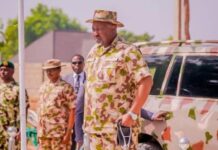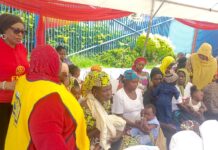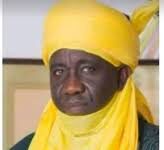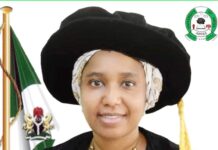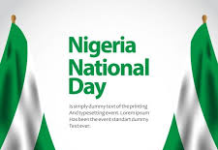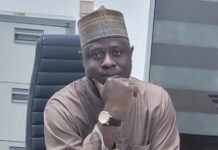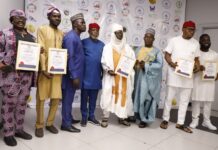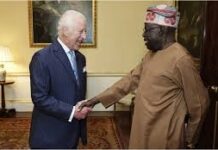There Was a Vision Called 2020, By Kayode Idowu
POLITICS DIGEST – Sloganeering for development planning in Nigeria gained especial notoriety in the Second Republic with the promise of everything for everyone by the year 2000. There were projections by the administration then in power of ‘housing for all,’ ‘food for all,’ ‘health for all,’ ‘transportation for all,’ nearly ‘idle riches air for all’ in that El Dorado year, which at the time seemed like eons away and a pole vault from grinding deprivations that most citizens were in reality trapped in.
The promises were so effusive and overwhelming that reputed author, Adebayo Lamikanra, penned a sardonic work in 1994 he titled ‘Wake Me Up in the Year 2000.’ But as the touted year got within view of attainment, it became assaultingly glaring that the bounties projected were an extravagant mirage; hence, the everything-for-all slogan surreptitiously dropped off the agenda of national conversation.
Then came the junta of the late General Sani Abacha in the mid-1990s with its mantra of Vision 2010, which was touted to guide Nigeria out of poverty and other developmental dredge pits like a bourgeoning population that the nation lacks capacity to feed, a monocultural economy that is dependent on crude oil resource for which the only outlet is the volatile international spot market, as well as ethnic and social cleavages that fuel perennial national instability. That vision, as it was articulated, aimed among others at fostering stable federalist democracy, rule of law and political accountability; strengthen the economy by boosting the gross domestic product (GDP); promote infrastructure growth, and educational as well as rural development; even tackle endemic corruption and prebendalism that characterised successive military regimes. But those objectives were grossly ironic because the Abacha junta that articulted them was perhaps the most autocratic and anti-rule of law of all regimes Nigeria ever had. Besides, it was altogether accountable to no one and outstanding in pathological looting of the public treasury.
Following the death of Abacha in 1998, General Abdulsalami Abubakar who took over as head of state upheld the Vision 2010, perhaps so because he was one of the principals of the Abacha regime and had participated in its formulation of the plan. But his administration was essentially transitory, with its major task being to swiftly install the civilian Third Republic. And so when Abubakar gave way for the civilian dispensation, former head of state General Olusegun Obasanjo, who took office in 1999 as first president of the new order, discarded the Vision 2010 in pursuit of his own programme anchored largely on privatisation of the economy and a discharge of the huge external debt portfolio.
It was the successor administration following the Obasanjo era, presided over by the late Umaru Yar’Adua, that threw up another long-term development planning mantra of Vision 2020. At the time the vision was formulated, it had more than 10 years in sight, which seemed long enough a time to pursue the target of propelling Nigeria into the league of 20 leading economies of the world by the year 2020. The official vision statement was as follows: “By 2020, Nigeria will have a large, strong, diversified, sustainable and competitive economy that effectively harnesses the talents and energies of its people and responsibly exploits its natural endowments to guarantee a high standard of living and quality of life to its citizens.”
Read Also:
The vision envisaged among other things that manufacturing and services would dominate the structure of national output while gross national investment would be greatly enhanced, with income per capita projected to rise from $1,230, which was the estimated level in 2008, to about $4,000. It was as well projected that macroeconomic stability would be entrenched and the economy firmly placed on sustainable growth path. One of the policy documents had further stated: “The main goal of Nigeria’s Vision 20:2020 is to improve the well-being of Nigerians. In this direction, the vision aims to reduce the problems of hunger, poverty, poor healthcare, inadequate housing, low quality human capital, gender imbalance, low productivity and poor basic facilities by 2020.”
Those ideally were objectives as lofty as any could get. But the Yar’Adua administration that articulated them was intrinsically feeble – largely because of health challenges that hobbled the otherwise admirable leader and ultimately cut short his tenure. That was besides the administration being encumbered and perhaps befuddled by a multi-headed agenda tagged ‘the seven-point agenda.’ Thereafter the sheer profligacy and rapacity of the Goodluck Jonathan presidency, which was an offshoot of the Yar’Adua government, could not hold up any drive towards the desired targets of Vision 2020. And the succeeding administration of President Muhammadu Buhari came in with avowed determination to reverse the rot, overhaul the dubious imprints of its predecessors and altogether reconstruct the guideposts of national development.
Thus it is that the envisioned year 2020 has now happened upon us; and as it was with preceding development plans, it is glaring we are far short of projections made in Vision 2020. Nigeria is today not among the 20 leading world economies. It is a middle income emerging market ranked the 27th largest economy in the world in terms of nominal GDP and 22nd largest in purchasing power parity. It is Africa’s largest economy ahead of South Africa though, with a GDP measured at $375.8billion in 2017 and projected to hit $500billion at the end of last year according to global macro models and analysts.
The catch is, this outlook is far from being inclusive. Contrary to Vision 2020 for instance, which projected reducing the problem of hunger and ensure high standard of living in the land, some 94.5million Nigerians out of country’s 180-200million population were estimated to be living in extreme poverty as at the last quarter of 2019 by the World Poverty Clock. The World Bank warned in its latest Nigeria Economic Update penultimate week that things could get worse, with up to 30million more citizens likely to slide into extreme poverty over the next 10 years unless economic reforms bring about robust productivity and inclusive growth.
Although the Buhari government has indicated distrust in foreign statistics on Nigeria, the president sometime last year acknowledged non-inclusive economic growth. Speaking at the opening of the 25th Nigerian Economic Summit in October, he said with Nigeria being a country having some 200million people living in 36 states and the Federal Capital Territory, a significant portion of its prosperity was “concentrated in the hands of a few people living primarily in four or five states and the FCT…(leaving) the remaining 31 states with close to 150 million people in a state of expectancy and hope for better opportunities to thrive.”
Unlike the ‘vision’ mantras, however, Buhari does not seem given to sloganeering with development planning. But he has promised a policy drive to take 100million Nigerians out of poverty over the next 10 years – expectedly so, not personally owing to term limits, but by laying “enduring foundations” towards achieving that end, as he restated in his New Year message to Nigerians early last week.
Rather than the Nigerian economy being strong and durable as envisaged in Vision 2020, the World Bank also noted penultimate week that it is indeed vulnerable to domestic and global risks. “It is facing a sharper than expected slowdown in the global economy as well as geopolitical trade tensions. Domestically, the predictability of macroeconomic policies, the pace of structural reforms and the country’s security situation are main risks,” the institution said in its report.
What the serial failure of policy mantras in Nigeria teaches is that the country does not need time-denominated visions but ethically imbued ones by leaders who have their eyes on the verdict of history.
Please join me on kayodeidowu.blogspot.be for conversation






